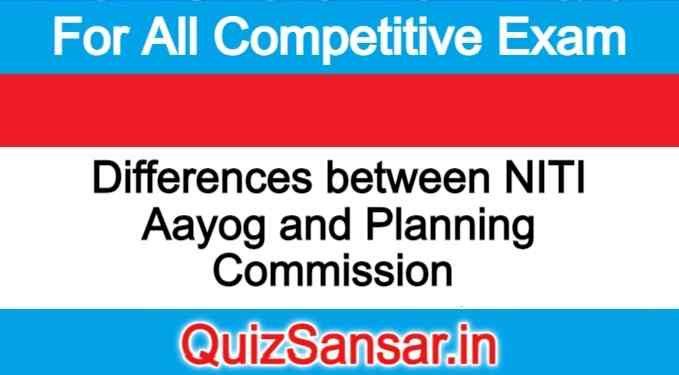
Differences between NITI Aayog and Planning Commission
NITI Aayog Planning Commission
NITI Aayog has not been given the mandate or powers to impose policies on States. NITI Aayog is basically a think-tank or an advisory body. The Planning Commission had the power to impose policies on States and for the projects approved by the Planning Commission.
The powers for allocation of funds have not been given to the NITI Aayog. The powers are with the Finance Ministry. The Planning Commission had the power to allocate funds to the State Governments
and various Central Government Ministries for various programmes and projects at National and State Levels.
In NITI Aayog, State Governments have to play a more proactive role. State Governments did not have much role to play apart from taking part in the meetings. The State Government’s role was confined to the National Development Council.
Based on the requirements, there are part-time members appointed in NITI Aayog. The Planning Commission did not have any provisions for the appointment of part-time members.
The Governing Council of NITI Aayog has Lieutenant Governors of Union Territories and State Chief Ministers. The National Development Council had Lieutenant Governors and State Chief Ministers. Planning Commission had to report to the National Development Commission
The CEO of NITI Aayog is appointed by the Prime Minister. Secretaries are known as CEO. Planning Commission secretaries were appointed through the usual process.
The number of full-time members in NITI Aayog could be lesser than the numbers that the Planning Commission had. The last Planning Commission had eight full-time members.
Under NITI Aayog organisation structure new posts were created – CEO, Vice-Chairperson. CEO has the rank of a Secretary. Four Cabinet members would serve as ex-officio members. NITI Aayog has two-part time members and five full-time members. The Planning Commission organisational structure consisted of full-time members, member secretary and a Deputy Chairperson.
In NITI Aayog, the final policy would bear fruit after due consultations are held with State Governments in the policy formulation stage. The Planning Commission first formulated policies and then State Governments were consulted regarding the allocation of funds for the programmes or projects.
NITI Aayog is also an Executive Body as it is not mentioned in the Constitution of India, and it was not established by an Act of Parliament. However, if needed it can be converted into a Statutory Body by passing a law in Parliament, an example is UIDAI. The now defunct Planning Commission was an Executive Body.






